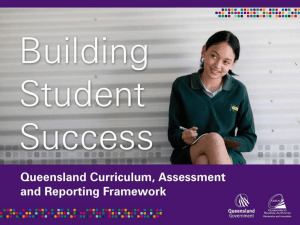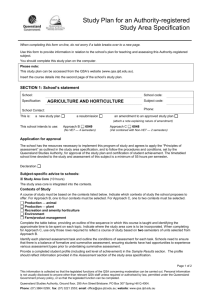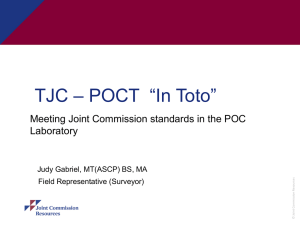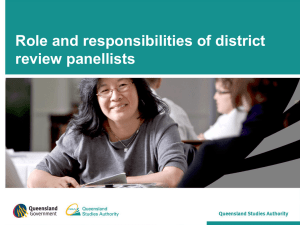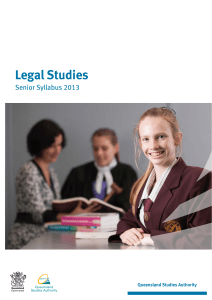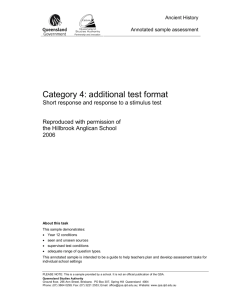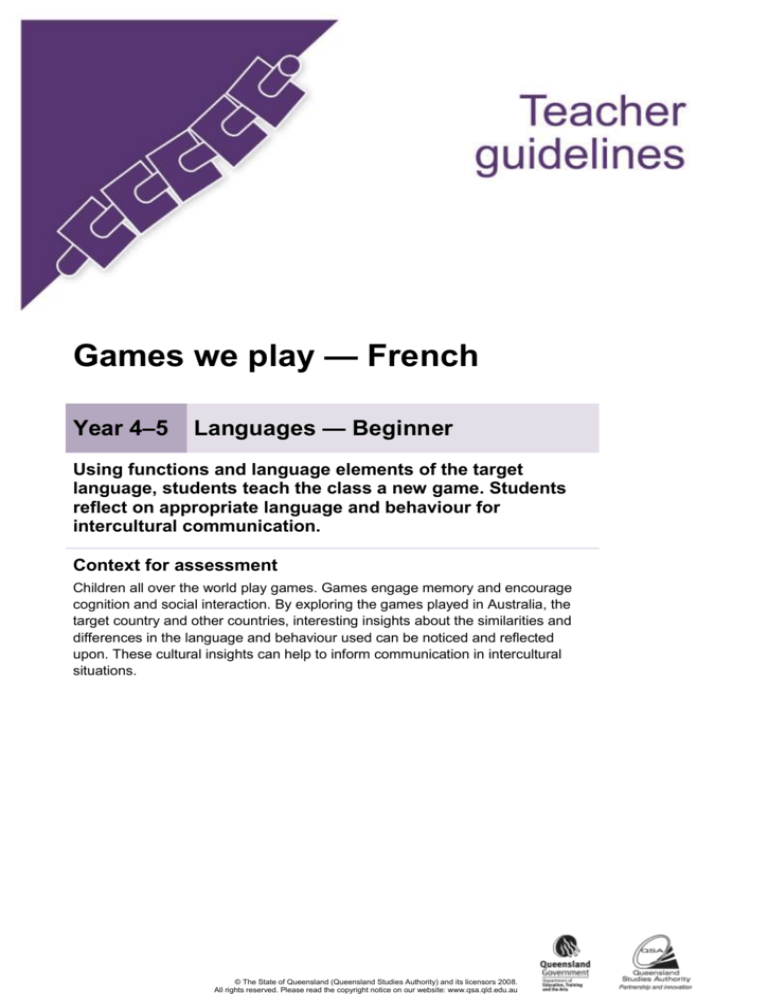
Games we play — French
Year 4–5
Languages — Beginner
Using functions and language elements of the target
language, students teach the class a new game. Students
reflect on appropriate language and behaviour for
intercultural communication.
Context for assessment
Children all over the world play games. Games engage memory and encourage
cognition and social interaction. By exploring the games played in Australia, the
target country and other countries, interesting insights about the similarities and
differences in the language and behaviour used can be noticed and reflected
upon. These cultural insights can help to inform communication in intercultural
situations.
© The State of Queensland (Queensland Studies Authority) and its licensors 2008.
All rights reserved. Please read the copyright notice on our website: www.qsa.qld.edu.au
Teacher guidelines
This assessment gathers evidence of learning for the following Essential Learnings:
Languages
Essential Learnings by the end of Beginner stage
Ways of working
Knowledge and understanding
Students are able to:
identify the purpose or main
topic in simple spoken and
written texts, using visual and
verbal language
Comprehending and composing in the target language
Comprehending and composing skills are used to
understand language input, to convey information and
to express ideas in response to needs and interests.
respond to familiar statements
and questions in simple
conversations and
discussions, using key words,
phrases and memorised
material
identify and use non-verbal
communication strategies in
familiar contexts
construct simple spoken and
written texts in familiar
contexts
notice and compare aspects of
the target language and
English and/or other familiar
languages
notice and compare aspects of
their own cultures and of the
target cultures
reflect on and evaluate the
suitability of language choices
in familiar contexts.
Verbal language and non-verbal language are used in
simple, routine exchanges to negotiate meaning.
Language forms, functions, grammar and vocabulary
are combined with process skills and strategies to make
meaning.
Listening for and locating key words and phrases, and
using memorised material helps to make meaning.
Manipulating known language helps to make meaning
in different contexts.
Intercultural competence and language awareness
Noticing and comparing similarities and differences
between languages and cultures informs intercultural
communication.
Ways of using language provide information about
cultures.
Languages and cultural practices have particular
features, conventions, patterns and practices that may
be similar to or different from one’s own language and
culture.
Assessable elements
Knowledge and understanding
Comprehending texts
Composing texts
Intercultural competence
Reflecting
Source: Queensland Studies Authority 2007, Language Essential Learnings by the end of Beginner stage, QSA, Brisbane.
Listed here are suggested learning experiences for students before attempting this assessment.
2
Year 4–5 Languages — Beginner: Games we play
The resources referred to in these learning experiences are available for download as assessmentrelated resources in the target language — French.
Orientating
Student language: identifying things: names of games, name, age, address; giving locations:
inside/outside, straight ahead, left, right, on, under, beside; describing activities: games – noisy,
quiet, fun, boring, safe, interesting, group, team, one person, two people; comparing: same,
different; giving and responding to instructions: your turn, my turn, like this, you’re out; identifying
and asking when: o’clock
1. Play “pass the parcel” to music from the target culture(s). The teacher prepares a parcel with
each layer of the parcel revealing a task in the target language. When the music stops, the
student with the parcel unwraps one layer and does the task described on a card (make cards
to practise target language already known to students). Model possible responses (using
flascards) then question students about whether they liked it, where it is usually played, how
many people are needed to play it and some of its characteristics. Model how to record
reponses on Resource 1 (on an OHT or data projector).
2. Listen and follow the words as the teacher reads a story “Around the world in eight days”
(Resource 2). Students record the names of countries visited, the game played in each
country and the way each game is described. Answer teacher questions about the places
visited and the games played using their recorded notes of the information. Students compare
the games in the story with ones they play in Australia. Emphasise that while each country has
special games, many games are the same all over the world.
3
Teacher guidelines
Enhancing
3. Listen to the teacher read a rhyme and demonstrate the clapping pattern suggested in
Resource 3. Chant the rhyme while clapping with a partner. Add information about the game
to Resource 1. Share opinions about the game with the class.
4. Listen to the teacher explain and demonstrate the rules for handball (Resource 4), then play
handball. Students add details about the game to Resource 1 and share opinions about the
game.
5. Practise the Alphabet song (Resource 5). Take turns to play a skipping game while singing the
Alphabet song, saying one sound per skip. Anyone who makes a mistake in the alphabet is
out. Students add details about the game to Resource 1 and talk to a partner to find out
whether both agree about their opinion of the game.
6. Listen to the teacher give instructions to play “Paper, scissors, rock” (open hand for paper;
index and middle fingers for scissors; closed fist for rock), and explain how paper beats rock,
rock beats scissors and scissors beats paper. Pairs play the game and continue heats until
there is a class winner. Students add details about the game to the chart (Resource 1).
7. Practise telling the time in pairs and draw that time on clock faces. Play “What’s the time Mr
Wolf?”. One student is the wolf. Other students creep up behind the wolf, asking “What’s the
time Mr Wolf?”. The wolf gives random times and at anytime the wolf can respond with “meal
time” and turn and chase the other students. The first person caught becomes the new wolf.
Students add details of the game to Resource 1 and find someone else in the class who
described the game in the same way.
8. Practise exchanging personal information (name, age, address). Play “Blind man’s buff”. One
student is blindfolded and spun around in the middle of a circle of students. The “blind man”
has to catch someone in the outer circle and ask questions to find out who it is. When students
answer, they can disguise their voices and give false information to confuse the “blind man”.
When the blind man identifies someone, that person takes over as “blind man”. Students add
details about the game to Resource 1.
9. Listen to instructions for a treasure hunt and follow clues that direct the students to a range of
tasks that they will need to complete (Resource 6). The teacher plans clues for around the
school or in the classroom. Groups of students can work together or individuals can race each
other to follow the instructions and complete the tasks. Different starting clues can be given so
that everyone is not at the same place at the same time. Students add details about the game
to Resource 1. During the treasure hunt, student comprehension of and responses to written
instructions can be observed. Resource 1 can be used as evidence of how well students use
key words and phrases to describe games.
10. Explore games unique to the target country. Play the games in the target language and
compare them with the types of games played in Australia. Children record how they are
similar and different to games they play. This could be done in a Venn diagram.
4
Year 4–5 Languages — Beginner: Games we play
Teacher resources
The following resources are available for download as assessment-related resources in the target
language — French.
Resource 1
Games we play
Resource 2
Around the world in eight days
Resource 3
Rhyme
Resource 4
Handball
Resource 5
Alphabet song
Resource 6
Treasure hunt
Syllabus and curriculum resources
The target language functions and elements that can be expected for students at the Beginner
stage of language learning can be found at: http://www.qsa.qld.edu.au/syllabus/830.html
Functions and suggested language elements, Queensland Studies Authority, accessed 6
March 2008, <www.qsa.qld.edu.au/syllabus/830.html>. (Language resources for students at
the Beginner stage of language learning. Use in conjunction with the Guide to making
judgments.)
Teachers can choose focus process skills and strategies to use when communicating in the
target language as appropriate to students’ prior experience with language learning e.g.
planning what to say, asking for repetition, taking risks with language. These can be found on
page 27 of the LOTE Years 4 to 10 Syllabuses at: http://www.qsa.qld.edu.au/syllabus/764.html
LOTE Years 4 to 10 Syllabus, p.26, Queensland Studies Authority, accessed 6 March 2008,
<www.qsa.qld.edu.au/syllabus/764.html>. (Process skills and strategies to use when
communicating in the target language.)
Student needs and teaching programs will determine the specific content of form-focused
instruction. More information about form-focused instruction can be found on the LOTE Years 4
to 10 Curriculum materials CDs. For information about how to obtain a CD can be found at:
http://www.qsa.qld.edu.au/syllabus/764.html
LOTE Years 4 to 10 Curriculum materials CD-ROM (Information on form-focused instruction)
and LOTE Years 4 to 10 Syllabus CD-ROM for Middle Primary students (Leisure and
recreation module: Games we play): <www.qsa.qld.edu.au/yrs1to10/kla/lote/publications.html>.
Websites
Cultural education publication from the University of Florida: <http://edis.ifas.ufl.edu/4H055>.
Traditional games website: <www.tradgames.org.uk>.
Scholastic games resources: <http://content.scholastic.com/browse/article.jsp?id=11441>.
5
Teacher guidelines
Preparing
Consider these points before implementing the assessment.
Teachers should ensure that students have had ample opportunities to use the functions and
language elements needed to give and follow instructions in a game.
If a game selected by the student involves physical activity, take into consideration health and
safety issues.
Liaise with the class teacher to ensure that the tasks chosen are inclusive of all students,
including factors such as ability and disability, and cultural and linguistic backgrounds.
Prepare a roster to give each student the opportunity to present their game to the class
(Appendix A).
6
Year 4–5 Languages — Beginner: Games we play
Sample implementation plan
This table shows one way that this assessment can be implemented. It is a guide only — you may
choose to use all, part, or none of the table. You may customise the table to suit your students and
their school environment.
Suggested time
Student activity
Teacher role
Resources
Section 1. Game play
1 hour
Using the target language,
design a game to teach to
the class.
Provide assistance to students
where required.
Palm cards or
notes
10–15 minutes
Enter details of the game
onto the student roster in
the target language.
Create a roster to give each
student the opportunity to
present their game to the class
Student roster
(Appendix A)
Times will vary for
each student
depending on the
nature of their game
and engagement of
other students with
the game. Games
can also be played
across a several
lessons.
Use appropriate target
language to play a game
that they have created in a
format of their choice (e.g.
active, noisy).
Provide appropriate equipment
for students to prepare a game
that could be quiet, active,
indoor, outdoor, etc.
Equipment for
games
Give opinions about the
games taught by others.
Divide the class into those
playing and those observing to
help with individual
assessment.
Observe students’
comprehension of appropriate
target language elements when
playing games designed by
others.
Section 2. Reflection: Intercultural communication
10–15 minutes
Complete Section 2 of the
Student booklet to reflect
on an appropriate game,
language and behaviour to
engage visiting students
from the target country.
Focus on samples of students’
reflections and guide a
discussion that considers the
appropriate language and
behaviour to use in an
intercultural exchange.
Resources for the assessment
Appendix A
Student roster
Students record the details of the game they will present to the class, and when
they will be presenting.
7
Teacher guidelines
During the learning process, you and your students should have developed a shared
understanding of the curriculum expectations identified as part of the planning process.
After students have completed the assessment, identify, gather and interpret the information
provided in student responses. Use only the evidence in student responses to make your judgment
about the quality of the student learning. Refer to the following documents to assist you in making
standards-referenced judgments:
Guide to making judgments
Indicative A response
Sample responses (where available).
For further information, refer to the resource Using a Guide to making judgments,
available in the Resources section of the Assessment Bank website.
Evaluate the information gathered from the assessment to inform teaching and learning strategies.
Involve students in the feedback process. Give students opportunities to ask follow-up questions
and share their learning observations or experiences.
Focus feedback on the student’s personal progress. Emphasise continuous progress relative to
their previous achievement and to the learning expectations — avoid comparing a student with
their classmates.
For further information, refer to the resource Using feedback, available in the
Resources section of the Assessment Bank website.
8
Appendix A
Student roster
Name
Game
Location
Description
(inside/outside)
(no. of people, equipment needed)

